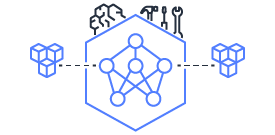This document is relevant for: Inf2, Trn1, Trn2
nki.isa.activation_reduce#
- nki.isa.activation_reduce(op, data, *, reduce_op, reduce_res, bias=None, scale=1.0, mask=None, dtype=None, **kwargs)[source]#
Perform the same computation as
nisa.activationand also a reduction along the free dimension of thenisa.activationresult using Scalar Engine. The results for the reduction is stored in the reduce_res.This API is equivalent to calling
nisa.activationwithreduce_cmd=nisa.reduce_cmd.reset_reduceand passing in reduce_res. This API is kept for backward compatibility, we recommend usingnisa.activationmoving forward.Refer to nisa.activation for semantics of
op/data/bias/scale.In addition to nisa.activation computation, this API also performs a reduction along the free dimension(s) of the nisa.activation result, at a small additional performance cost. The reduction result is returned in
reduce_resin-place, which must be a SBUF/PSUM tile with the same partition axis size as the input tiledataand one element per partition. On NeuronCore-v2, thereduce_opcan only be an addition,np.addornl.add.There are 128 registers on the scalar engine for storing reduction results, corresponding to the 128 partitions of the input. These registers are shared between
activationandactivation_accucalls. This instruction first resets those registers to zero, performs the reduction on the value after activation function is applied, stores the results into the registers, then reads out the reduction results from the register, eventually store them intoreduce_res.Note that
nisa.activationcan also change the state of the register. It’s user’s responsibility to ensure correct ordering. It’s the best practice to not mixing the use ofactivation_reduceandactivation.Reduction axis is not configurable in this API. If the input tile has multiple free axis, the API will reduce across all of them.
Mathematically, this API performs the following computation:
\[\begin{split}output = f_{act}(data * scale + bias) \\ reduce\_res = reduce\_op(output, axis=<FreeAxis>)\end{split}\]Estimated instruction cost:
max(MIN_II, N) + MIN_IIScalar Engine cycles, whereNis the number of elements per partition indata, andMIN_IIis the minimum instruction initiation interval for small input tiles.MIN_IIis roughly 64 engine cycles.
- Parameters:
op – an activation function (see Supported Activation Functions for NKI ISA for supported functions)
data – the input tile; layout: (partition axis <= 128, free axis)
reduce_op – the reduce operation to perform on the free dimension of the activation result
reduce_res – a tile of shape
(data.shape[0], 1), where data.shape[0] is the partition axis size of the inputdatatile. The result ofsum(ReductionResult)is written in-place into the tensor.bias – a vector with the same partition axis size as
datafor broadcast add (after broadcast multiply withscale)scale – a scalar or a vector with the same partition axis size as
datafor broadcast multiplydtype – (optional) data type to cast the output type to (see Supported Data Types for more information); if not specified, it will default to be the same as the data type of the input tile.
mask – (optional) a compile-time constant predicate that controls whether/how this instruction is executed (see NKI API Masking for details)
- Returns:
output tile of the activation instruction; layout: same as input
datatile
This document is relevant for: Inf2, Trn1, Trn2
